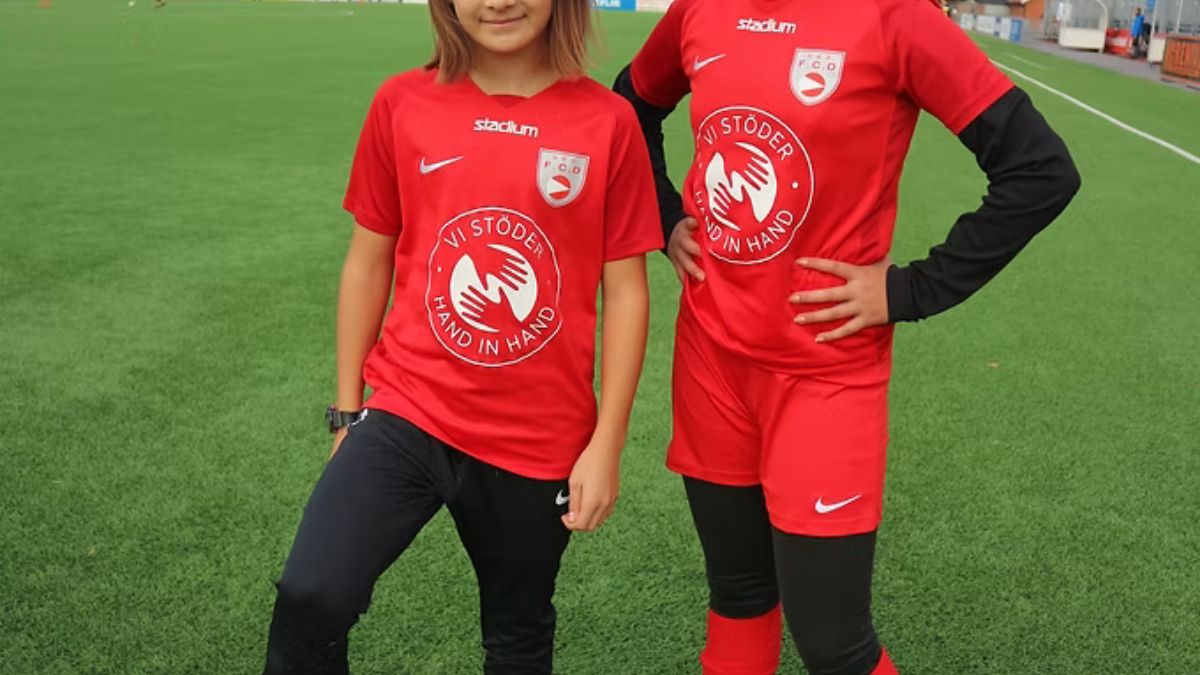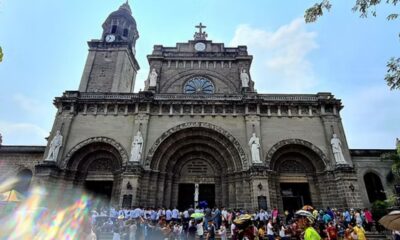TOPIC
Pinoy Power on the Pitch

Two Filipina-Swedish soccer players pack a punch on the pitch and help their team to a first-place finish in the World Youth Soccer Cup! There’s something incredible about watching the remarkable change that occurs in children when they play team sports. One moment my daughter is lying contentedly in bed, studying YouTube videos incessantly to improve her slime-making formulas and squishy-repair capabilities, then, the call to arms is announced: “Time to get ready for the game!” and with a yawn and a stretch she’s up and starts getting ready for battle. Like a miniature Gladiator she adorns her “armor” of cleats, shin-guards and fiercely colored uniform, and rushes out onto the battleground where the transformation is complete. The team, pint-sized spitfire packages of energy, on the frontline of the dewy/snowy/frozen pitch (depending on the season in Sweden), allied in challenging foes and crushing enemies. Their individuality disappears and they morph into a single organism, moving in tandem, in a coach-choreographed dance toward, hopefully, victory. The transformation comes full circle only forty minutes later as she rests in the backseat of my soccer mom car, peaceful once again, feeding carrots to her Minecraft farm animals. The World Youth Soccer Cup winning Djursholm’s Soccer Club team F07 with their coaches. The story of the Djursholm Soccer Club girls team F07 (born in 2007 and aged 11) is a modern-day David vs Goliath. All the girls on the team come from the unique community of Djursholm (pronounced Yersh-holm), a small town with a population of just 8,800 people that lies twelve quick minutes north of Stockholm. This small team from the very small town is exceptional, and in their short career, they’ve had remarkable success against clubs from huge cities. Behind these results is the combination of a unique set of circumstances brought together to create a dream team: a physically extraordinary batch of players, each with specific expertise and natural talents in certain positions; outstanding, dedicated coaches; overwhelmingly supportive families; and a nurturing community environment. Sweden is unique in that the soccer association does not allow official scoring to be published until players are 12 years old. However, that doesn’t stop people from counting and in the end everyone still knows the victorious and vanquished team. At the 2017 unofficial National Championship Halör Cup, Djursholm F07 emerged as the best team in Sweden (although they lost the final to Denmark). Regardless, the team bullishly left the tournament scoring a total 29 goals and conceding only 1. Pretty phenomenal. Djursholm F07 was also awarded Team of the Year in 2016 by their soccer club when they won the St Erik’s Cup (the largest soccer cup in Stockholm) for their age group AND for the year older than them (they competed in both age groups at the tournaments simultaneously). In 2018, they claimed the ultimate achievement – first place at the Gothia World Youth Cup, tied with China. The Gothia World Youth Cup, most recently held in July 2018, is the world’s largest junior soccer championship and was attended by 1750 teams from 80 countries. During the week-long tournament Djursholm played against many teams but certain matches were more significant because of the magnitude of the competition. The Djursholm girls met fierce opposition in the game against JSSL Singapore, a club that is affiliated with the famed Arsenal and that hosts Asia’s largest youth soccer championship. Singapore also has the advantage of sourcing their team from a population of 5,600,000 people. Result? Little Djursholm won. Djursholm also competed against a team from Qiongzhong, China, a mountainous region known for cultivating soccer players for five generations. Apparently, years of climbing the mountains have made them incredibly fit, and their reactions and reflexes are supposed to be razor sharp. At the end of the contest Djursholm emerged victorious. Next, Djursholm met their toughest competitors so far: Shanghai’s Jinshan Xingsta, an “academy” team, which means that their school focuses strictly on soccer training and producing elite soccer athletes. They can draw on an enormous Goliath-sized population of 24,000,000 people to source the best of the best players. In complete contrast to the tiny Djursholm Soccer Club which has just one large and one small field where the team practices for 4.5 hours every week, Shanghai’s team, which trains for two hours EVERYDAY, has dozens of soccer fields at their disposal. Abi practices her powerful kicks. As mentioned earlier, the Gothia Cup and the Swedish Soccer Association do not allow results to be displayed at the girls’ age, but anyone who can count can add up the points of the matches and Djursholm emerged triumphant in a shared first place position with Shanghai’s Jinshan Xingsta. At the tournament’s close, both FC Djursholm and Jinshan Xingsta each won six matches and lost one finishing with 18 points each, an outstanding achievement against the toughest possible opposition. The final results of the 2018 Gothia World Youth Cup for girls aged 11: 1) FC Djursholm, 18 points (out of 21 possible) together with Jinshan Xingsta, 18 points, 3) JSSL Singapore, 16 points. Apart from being endowed with unique abilities, the Djursholm F07 team is also partly driven by two Swedish-Filipina players, Abigail (Abi) Fallenius and my daughter Filippa Babes Skarne, both aged 11. Abi started playing soccer at the age of 6 because her big sister Hana played and she accompanied her. Abi’s favorite thing about soccer, in addition to winning, of course, is the team spirit and the rewards that come from her physical and mental efforts including happy endorphins! Abi is the daughter of Swede Peter Fallenius and Filipina Juliet who hails from Banaue in Ifugao Province, Luzon – which is famed for its rice terraces. Juliet has lived in Sweden for 17 years and maintains Filipino traditions with the Filipino Cultural Association of Stockholm, food, music and traditional dances. Peter has been to the Philippines several times, at first for work and then with family, and has fond memories of a friend’s wedding in Nasugbo and a New Year’s Eve in Baguio. “It is a big country, a beautiful country. Lots of opportunities thanks to nice, hard working people,” says Peter. Filippa Babes started playing soccer at the age of 7, a few years after most of her teammates, but took to the game immediately. She inherits her athletic and muscular frame from her father, Filip Skarne, as well as her speed and stamina. She plays the role of striker, responsible for hammering the ball into the net. Filippa has been to the Philippines a handful of times for family occasions, most recently to watch her big sister Cloie represent Sweden as Miss Earth Sweden in the international pageant, and of course Filip was there too. Filip’s favorite place in the Philippines is a tie between the enormous private island in El Nido of our recently deceased friend Eduardo Vaca, who, when not using it privately rented it to networks worldwide to film “Survivor”, and my family’s ancestral home in the Spanish colonial town of Vigan, The Syquia Mansion, now a museum and a UNESCO World Heritage site. Filippa continues to sharpen her skills. The magic of the team is not only in the players of course: if the players are the ingredients, then the coaches are the chefs. The secret sauce of Djursholm F07 lies in the fact that it is coached by three amazing individuals, two of whom are volunteer dads: Jonus Bartholdson (father of player Fabienne), Martin Roos (father of player Mathilda) and Robert Assadkhan, who works at a bank full-time and coaches because of his love for the game. There’s a passion from these three that you can’t put a price on and a dedication that goes beyond anything you could ever find in a 9 to 5 job. I’d say it’s like having your own business: it’s a labor of love and personal pride that is with you 24-7. Coach Robert played at the elite level until he was 18 years old when he started taking coaching courses. He’s now in his 11th year as a youth coach. Robert wanted to work with children and to develop young players. “I had very good coaches myself and wanted to pay it back in a way. I knew it would develop me as a person also,” says Robert. He also shed some light on what makes this team so special. “I came back to the Djursholm club after my session in Djurgården (a prominent Swedish soccer club) and had a few offers on the table. I was offered to coach 16 and 17 year olds at the elite level, both girls and boys, but I wanted something else. I didn’t feel the thrill and motivation that I had earlier. When F07 turned up as an offer, I immediately felt my motivation come back! To work with the girls from an early stage and be able to develop and prepare them for 11–a-side games and higher levels of soccer was really appealing to me. This was a good choice as these girls are fantastic! Not only are they very talented, some of them easily the best in Sweden, but they have also given me the joy and happiness of coaching soccer again. Of course, we win a lot – and it’s fun to win – but it’s not only that: the feelings of friendship, support and always wanting to make progress and learn new things are fantastic!” Dad coaches Jonus and Martin decided together to take over the responsibilities of coaching when they saw their daughters’ team. They both volunteer their time after work and during weekends to train and coach the team. The F07 is the only team at the Djursholm Soccer Club that is being coached by dads. Coach Jonus played professional soccer as a forward in the Allsvenskan (Premier League in Sweden) for three years. “I have had many coaches during my soccer career, some really good ones, some bad ones. I am genuinely interested in helping people to grow, more than just the game itself, so when my daughter started playing matches four years ago, I offered my services to the club to take responsibility for the team. I felt I could help develop them not only as players but also as people,” says Jonus. Coach Martin Roos started his soccer career at the age of 6 and by the time he was 12 was recruited to play for Sweden’s biggest club – AIK. He played in the Junior Swedish Premier League until he, unfortunately, injured both knees at the age of 18 which was sadly the untimely end of his soccer career. He had no plans of being a children’s coach until he saw the team at their first training session and recognized their talent and potential. He and Jonus decided that they wanted to be a part of it. Not all serious training: the girls have some fun on the pitch! “First and foremost, this batch is exceptionally talented, but they also have fantastic cohesion and respect each other as individuals. Last but not least, they undoubtedly have the best coaches one can find,” Martin says with a wink. The familiar saying goes, “It takes a village to raise a child” and Djursholm, with its sleepy one-block-long main street, is a small village. In the US where I was raised, to emphasize the smallness of a place, we call it a “one traffic-light town”. Djursholm doesn’t even have a traffic light in its town center (there are a couple scattered near schools to slow cars down). People often wonder if there is something special in the water in Djursholm or is it true what the recent best-selling Swedish book about the suburb titled: “Djursholm – Making of Leaders” (Mikael Holmqvist) hypothesizes: even though the town is small, the population is mainly made up of successful industry leaders, movers and shakers – many whose families have lived there for generations – that sustain a community that raises its children to be like them, quite simply put: to be winners. Djursholm is to Stockholm what Greenwich is to New York City, and Beverly Hills is to Los Angeles: a small, tight-knit enclave of leaders that through hard work, networking and a sense of togetherness, help their children thrive. The cherry on top of the team’s remarkable success is an extraordinary level of parental involvement. Parent meetings are standing-room only events that at first occupied a conference room in the clubhouse, but now have had to move into the cafeteria for lack of space. Sidelines at away games are well represented with cheering parents, siblings and grandparents and home games, of course, even more so. The world’s greatest athletes come from very different socio-economic backgrounds (Pele from poverty, Ronaldo from poverty, the Williams sisters ‘Straight Outta Compton’ in LA, the list goes on and on) and while there is a lot to be said about how birth month can influence athletic abilities, there are always exceptions. But one thing the majority of successful athletes have in common is this: truly involved parents that encourage their children’s passion and provide a support system to help their participation in the sport. Whether driving them here and there, making sure their uniform and equipment are ready, taking part in supporting their schedules, being part of the planning, or just being on the sidelines and cheering them on to victory. Family involvement, or the lack thereof, is hugely influential and plays a significant role in the success or failure of athletes. Djursholm F07 has enormous parental involvement. At one tournament abroad last year our team had about 15 parents and siblings along and two mom team managers (myself and my amazing co-manager Marie Elmlund – mother of player Julia) with the 12 players – in stark contrast to another team that had just 2 parents with them. The convergence of all of these key advantages has provided the perfect spark for the little dream team in Djursholm and the future looks very promising. There’s talk of possibly participating in Asia’s biggest soccer cup in Singapore where they might meet teams from the Philippines, or perhaps staying closer to home and competing in Barcelona — and there’s always the chance of playing in the Gothia World Youth Cup next year. Until then, the girls will keep on doing what they do best – being kids and having fun and playing hard. As they share unforgettable moments together with their team they’re being meticulously transformed both physically and mentally every day to be victorious both on and off the field. We’ve become an extended family of sorts: coaches like extra parents, teammates like siblings, and hopefully, team managers like me and Marie, as extra moms. The coaches speak about Abi, Filippa and the Philippines: About Abi
“Abi is a well-educated player, very tough to play with 1vs1 and often has a physical advantage, very flexible in her movements.” Robert “Abi is a hardworking and intelligent player. She reads the game well, she passes well, and she has a strong breakthrough capacity coming from behind, either from a defense position or as a wing midfielder.” Jonus “Abi is a very happy and sweet girl. Her strength as a soccer player is that she is very stable, confident in stealing the ball, and is skilled at passing.” Martin About Filippa
“Our own energy source Filippa! Probably the best offensive player I have ever seen or worked with in this age. Has a natural gaze on the goal and is extremely confident and safe with the ball.“ Robert “Filippa is one of the most technically skilled players in the team and our best goal scorer. She is fast, she regains possession of the ball from the opponents a lot and is very skilled in passing and breakthroughs. She also shoots well with both feet.” Jonus “Filippa is a very happy, considerate girl with a sparkle in her eye! She is a typical striker: fast, technical, and a fantastic shot!” Martin About the Philippines:
“The Philippines is a dream vacation. I actually studied a bit about the Philippine freedom fighters Lapu-Lapu and José Rizal in my political studies.” Robert “I’d really like to go to the Philippines one day. I’ve heard from people who have been there that it is incredibly beautiful!” Martin “I would love to go to the Philippines! The climate is warm, it is a great recreational place, and there are lovely people. The economy is also picking up.” Jonus The girls speak about the Philippines From Abi
”My favorite place in the Philippines: Banaue where my mother is from, and our home in Manila My favorite food: Adobo (or as she calls it, ”Mammas special chicken”) and dried mango My favorite things to do: I’m very musical and sing in a choir and play flute. That definitely comes from my Philippine genes! The combination of sports and music/singing improves me both mentally and physically.” From Filippa
”My favorite place in the Philippines – My favorite place is the beach in El Nido and the Boracay Shangri-La My favorite food – Chicken Adobo! My favorite things to do – I love to see my family! My mother has 46 first cousins on my Lolo’s side, so I have so many relatives!” Filippa with mother Jenny and Abi with mother Juliet. About the Author Jenny Syquia Skarne is the Djursholm F07 team manager or “momager” as she prefers. “Never in my wildest of dreams did I ever envision myself being a soccer mom, and definitely not a soccer team manager, but I love it!” The Filipina-American is the daughter of the recently deceased Victor Syquia from Ilocos Sur and American Susan Syquia. Jenny lived in the Philippines for several years working as a commercial model, starring in several movies with Fernando Poe, Joey de Leon, Charlene Gonzales and Ina Raymundo, and hosting the daytime TV show Eat Bulaga. She started her writing career at Vogue in New York City working for Anna Wintour, and then founded and was Editor-in-Chief of Bride Philippines. She is the author of the soon to be released children’s illustrated book, “Cloie’s Be Yourself Style” that you can read more about at www.JennySyquia.com. Check out Filippa’s soccer YouTube channel:
Soccer Girl Filippa Skarne Learn more about the charity supported by the Djursholm Soccer Club: www.HandInHand.nu
TOPIC
Elampillai Festivals: Celebrating Tradition and Community

Introduction to Elampillai Festivals
Elampillai, a vibrant town nestled in the heart of Tamil Nadu, bursts with life during its annual festivals. These celebrations are more than just events; they embody the essence of community spirit and rich traditions. Each festival brings together locals and visitors alike, creating an atmosphere filled with joy, color, and cultural pride. From captivating rituals to mouth-watering delicacies, Elampillai’s festivals offer a unique glimpse into the heritage that has shaped this remarkable region for generations. Join us as we explore what makes these festivities so special and how they continue to connect people through shared experiences and cherished customs.
History and Significance of Elampillai
Elampillai, a picturesque town in Tamil Nadu, carries a rich tapestry of history. Its roots stretch back centuries, intertwining with the cultural heritage of the region. The area is known for its significant contributions to art, literature, and spirituality.
Historically, Elampillai served as a vital hub for trade and community gatherings. This prominence allowed diverse traditions to flourish. Festivals emerged as vibrant expressions of local identity.
The significance of these celebrations extends beyond mere festivities. They embody the resilience and unity of the people. Each event tells stories passed down through generations; they connect communities while honoring ancestral customs.
People from surrounding areas often gather during these times, fostering relationships that strengthen social ties. In every aspect—be it food or rituals—the essence of Elampillai’s culture comes alive through its festivals.
Major Festivals and Celebrations
Elampillai is vibrant with a variety of festivals that reflect its rich cultural tapestry. Each celebration brings together the community in joyful harmony.
One of the most notable events is Pongal, a harvest festival celebrated with great enthusiasm. Families prepare special dishes and engage in traditional games, showcasing unity and gratitude for nature’s bounty.
Another significant occasion is Thaipusam. This festival attracts devotees who partake in ceremonial rituals to honor Lord Murugan. It’s a time for reflection and spiritual renewal, drawing visitors from far and wide.
The Aadi Perukku festival marks the monsoon’s arrival. The local rivers come alive as families gather along their banks to offer thanks through prayers and food offerings.
These celebrations are not just events; they weave stories of faith, tradition, and communal bonds that define Elampillai’s identity.
The Cultural Traditions and Customs of the Festivals
Elampillai festivals are a vibrant tapestry of cultural traditions and customs that reflect the community’s rich heritage. Each celebration is marked by unique rituals, showcasing local art forms, music, and dance.
During these festivities, traditional attire takes center stage. Residents often don colorful garments that represent their identity and pride. The streets come alive with folk dances performed to the rhythm of drums and other musical instruments.
Food also plays an essential role in these celebrations. Special dishes prepared for the occasion carry recipes passed down through generations, highlighting the region’s culinary diversity.
Moreover, temple processions are a significant aspect of Elampillai festivals. Devotees gather to pay homage to deities while engaging in spiritual practices that strengthen communal bonds.
The atmosphere buzzes with excitement as locals participate in games and activities rooted in tradition, fostering unity among families and neighbors alike.
Impact on the Local Community
The impact of Elampillai festivals on the local community is profound. These events foster a sense of belonging among residents, drawing people together in celebration and shared joy. The vibrant atmosphere encourages participation across all age groups.
Local businesses thrive during these festivities as visitors flock to the area. Street vendors set up stalls offering traditional foods, while artisans showcase their crafts. This economic boost supports families and strengthens community ties.
Moreover, festivals serve as a platform for cultural exchange. Different generations share stories and practices, ensuring that traditions are passed down. In this way, younger members learn about their heritage in an engaging manner.
Additionally, the festivals often promote social causes or charitable initiatives, uniting everyone under a common goal. Through collective efforts, they inspire positive change within the community itself.
Preserving the Heritage through Festivals
Festivals are more than just celebrations; they embody the essence of a community’s heritage. In Elampillai, each festival is a vibrant tapestry woven with history, beliefs, and customs passed down through generations.
These events serve as living museums where traditions come alive. Elders share stories that breathe life into the past while younger generations learn their cultural significance. This intergenerational exchange fosters pride in one’s roots.
Moreover, local artisans showcase traditional crafts during these festivities. Handcrafted goods tell tales of skill and artistry unique to Elampillai. The marketplace buzzes with activity, creating an atmosphere rich in culture.
As participants engage in rituals and performances rooted in ancient practices, they reinforce their connection to their ancestors. Each dance step or song sung reverberates with meaning that transcends time.
Through festivals, Elampillai not only preserves its identity but also nurtures a sense of belonging among its people.
Conclusion
Elampillai is more than just a location; it embodies a vibrant tapestry of culture and tradition. The festivals held here are not only moments of joy but also serve as powerful reminders of the rich history that shapes this community. Each celebration brings people together, reinforcing bonds and creating lasting memories.
The significance of these festivals extends beyond mere festivities. They reflect the values and beliefs that have been passed down through generations, ensuring that the essence of Elampillai remains intact. As each event unfolds, it showcases the resilience and unity among its residents.
As we look to the future, preserving these traditions will be essential. Festivals in Elampillai represent a living heritage that nurtures identity while adapting to contemporary society’s changes. By participating in these celebrations, both locals and visitors can engage with a community deeply rooted in its past yet optimistic about what lies ahead.
Through every dance performed, every song sung, and every dish shared during these festive times, Elampillai continues to thrive as a beacon of cultural richness—a place where tradition meets modern life harmoniously. Embracing this spirit ensures that future generations will inherit not just stories but experiences filled with love for their roots.
TOPIC
Silver Nitrate in Art Restoration: A Hidden Gem for Conservators

Introduction to Silver Nitrate
Art restoration is a delicate dance between preserving history and enhancing beauty. Among the many tools in a conservator’s toolkit, silver nitrate often goes unnoticed—a hidden gem with remarkable properties. This fascinating compound has been employed for centuries, playing an essential role in maintaining and restoring some of the world’s most cherished artworks. As we dive into the world of silver nitrate in art restoration, you’ll discover its rich history, numerous benefits, and real-life applications that showcase its unique abilities. Prepare to be intrigued by how this simple chemical can bring masterpieces back to life!
History of Silver Nitrate in Art Restoration
Silver nitrate has a storied history that dates back to the ancient Romans. They discovered its light-sensitive properties, which laid the groundwork for future applications in various fields, including photography and art restoration.
In the 19th century, conservators began recognizing silver nitrate’s potential in preserving artworks. Its ability to react with certain pigments made it an appealing choice for cleaning and restoring delicate surfaces without causing damage.
By the early 20th century, silver nitrate gained traction among professionals as a reliable solution for addressing tarnished or faded areas of paintings. The compound’s versatility allowed restorers to tackle diverse challenges while maintaining artistic integrity.
As techniques evolved over time, silver nitrate remained a go-to substance due to its effectiveness and relative safety when handled properly. It became synonymous with meticulous care in art conservation efforts around the globe.
Benefits of Silver Nitrate for Art Conservation
Silver nitrate offers remarkable benefits for art conservation, making it a preferred choice among conservators. Its antimicrobial properties help prevent the growth of mold and bacteria on delicate artworks. This is crucial in preserving both the aesthetic and structural integrity of various pieces.
Additionally, silver nitrate acts as a versatile cleaning agent. It can effectively remove unwanted tarnish or stains without damaging the underlying materials. This gentle approach ensures that the original work remains intact while enhancing its appearance.
Another significant advantage is its light sensitivity. When exposed to light, silver nitrate undergoes a chemical reaction that allows for precise control during restoration processes. Conservators can achieve desired effects with minimal risk of overexposure or damage.
Silver nitrate’s historical significance adds depth to its appeal in art restoration practices. Using this compound connects modern conservators with traditional methods, creating a bridge between past and present techniques.
Application of Silver Nitrate in Art Restoration
Silver nitrate serves multiple purposes in art restoration. Its versatility makes it invaluable for conservators working with various materials.
One primary application is its use as a cleaning agent. When applied to artworks, silver nitrate effectively removes dirt and grime without damaging the underlying layers. This gentle approach preserves the integrity of fragile surfaces.
Additionally, silver nitrate can help stabilize fading colors in paintings. By carefully applying this compound, restorers can enhance hues that have dulled over time. It acts as a protective layer, preventing further degradation from environmental factors.
In cases involving paper or textiles, silver nitrate aids in repairing delicate fibers. It bonds well with organic materials, making it ideal for mending tears while maintaining flexibility and strength.
This solution’s unique properties make it an essential tool in the conservator’s arsenal—one that continues to evolve alongside modern restoration techniques.
Case Studies: Successful Use of Silver Nitrate in Art Conservation
One remarkable example of silver nitrate in art conservation involves the restoration of a 17th-century portrait by an unknown artist. The painting had suffered extensive damage, particularly from discoloration and fading. Conservators applied silver nitrate carefully to rejuvenate the colors without compromising the original materials.
Another case worth mentioning is a famous mural that displayed signs of chemical deterioration. By utilizing silver nitrate solutions, conservators were able to stabilize the affected areas while preserving intricate details. This method allowed for minimal intervention, which is crucial in maintaining artistic integrity.
Additionally, during the restoration of antique textiles, silver nitrate has proven effective in removing stains caused by previous treatments. Its ability to target specific pigments made it invaluable for reviving these delicate pieces without introducing further risk or damage. Each case highlights how versatile and essential this compound can be within various conservation contexts.
Challenges and Precautions
While silver nitrate holds promise in art restoration, it is not without its challenges. One major concern is the potential for staining. Improper application can leave unwanted marks on artwork, damaging the very piece conservators aim to preserve.
Another issue involves safety precautions. Silver nitrate is a hazardous chemical that can cause skin irritation and other health issues if mishandled. Conservators must wear protective gear during use to ensure their well-being.
Moreover, proper storage of silver nitrate solutions is crucial. Exposure to light or air can reduce its effectiveness over time, leading to inconsistent results when restoring artworks.
Understanding the specific artwork being treated is vital. Different materials react uniquely with silver nitrate; what works for one medium may not suit another. Careful consideration ensures successful outcomes while minimizing risks associated with this powerful tool in art conservation.
Conclusion
Silver nitrate is proving to be an invaluable asset in the field of art restoration. Its unique properties make it a versatile tool for conservators, enabling them to address various challenges faced during the preservation process. The historical significance and evolving techniques surrounding its application highlight its importance.
From enhancing color vibrancy to ensuring structural integrity, silver nitrate has demonstrated remarkable benefits across multiple case studies. Conservators have successfully harnessed this compound to breathe new life into artworks that might otherwise deteriorate beyond repair.
However, working with silver nitrate does come with challenges. Proper precautions are essential when handling this chemical to ensure both safety and effectiveness in restoration efforts. Awareness of these factors allows conservators to maximize the potential of silver nitrate while minimizing risks.
The journey of silver nitrate in art conservation reveals its hidden gem status among restoration materials. As research continues and techniques evolve, one can only anticipate even more innovative uses for this remarkable substance in preserving our artistic heritage for future generations.
TOPIC
Albumīns Explained: Their Importance in Nutrition and Medicine

Introduction to Albumīns
Albumīns might not be a household name, but they play a vital role in our health and nutrition. These proteins are often overlooked yet essential for various bodily functions. Whether you’re an athlete looking to enhance performance or someone seeking to understand the nuances of nutrition better, understanding albumīns can open up new avenues for your well-being. From supporting muscle recovery to aiding in medical treatments, these proteins deserve more attention than they usually get. Let’s dive into what albumīns are all about and explore their significance in both nutrition and medicine!
The Role of Albumīns in Nutrition
Albumīns play a crucial role in nutrition, primarily as proteins that help maintain body fluids and support various physiological functions. They are abundant in blood plasma and contribute to the regulation of osmotic pressure, essential for fluid balance.
In dietary terms, albumīns can be found in foods such as eggs, fish, and dairy products. These sources provide high-quality protein necessary for muscle repair and growth.
Beyond their structural roles, albumīns assist in transporting nutrients throughout the body. They bind with vitamins and minerals, ensuring these vital substances reach cells effectively.
A diet rich in albumīn-enhancing foods can lead to improved energy levels and overall well-being. Incorporating enough albumīn into your daily intake is especially important during periods of growth or recovery from illness.
Benefits of Albumīns for the Body
Albumīns play a vital role in maintaining fluid balance within the body. They help keep water in the bloodstream, preventing it from leaking into tissues. This function is crucial for overall hydration and prevents swelling.
Additionally, albumīns transport essential nutrients like fatty acids and hormones throughout the body. Their ability to bind with various substances ensures that cells receive what they need for optimal functioning.
These proteins also contribute to immune system support. By acting as carriers for antibodies, albumīns enhance your body’s ability to fend off infections and diseases.
Moreover, considering their antioxidant properties, albumīns help protect cells from oxidative stress. This protection can reduce inflammation and promote better health outcomes over time.
Incorporating adequate levels of albumīns into your diet may lead to improved energy levels as well. A well-functioning protein framework supports metabolic processes essential for everyday activities.
Medical Uses of Albumīns
Albumīns play a pivotal role in modern medicine, particularly in patients with liver disease or malnutrition. They are crucial for maintaining oncotic pressure, which helps retain fluid within blood vessels. This function is vital during treatments that require fluid balance.
In critical care settings, albumin solutions are often administered to manage shock and prevent organ failure. It aids in stabilizing blood volume during surgeries or after traumatic injuries.
Moreover, the use of albumīns extends to conditions like burns and extensive surgical wounds. Here, they promote healing by supporting tissue repair and reducing inflammation.
Research continues on the therapeutic potential of albumīns beyond traditional uses. Their antioxidant properties suggest possible applications in chronic diseases where oxidative stress plays a role.
Types of Albumīns Supplements
When exploring albumīn supplements, several types cater to different needs.
Whey protein is one of the most popular forms. It’s derived from milk and packed with essential amino acids, making it ideal for muscle recovery.
Another option is egg white albumīn. This supplement offers a complete protein source without the fat found in whole eggs. It’s great for those looking to increase their protein intake without extra calories.
For vegetarians or vegans, plant-based albumīn supplements are available as well. These may combine various sources like peas and rice to provide a balanced profile.
Liquid albumīn products exist too, often used in clinical settings or by athletes needing rapid absorption post-workout.
Each type serves distinct purposes based on dietary preferences and specific health goals, ensuring there’s an option for nearly everyone interested in enhancing their nutrition through albumīns.
Risks and Side Effects
While albumīns offer numerous benefits, they are not without risks. Some individuals may experience allergic reactions, particularly those with sensitivities to specific proteins. Symptoms can range from mild rashes to severe anaphylaxis.
High doses of albumīn supplements might lead to increased fluid retention. This condition can put extra strain on the heart and kidneys, especially in those with pre-existing health issues.
Moreover, injecting albumīn for medical purposes carries potential complications. These may include infection at the injection site or transfusion-related reactions when administered intravenously.
It’s essential to consult a healthcare professional before starting any new supplement regimen, especially if you have underlying conditions or take other medications. Being informed helps mitigate these risks effectively while maximizing the benefits of incorporating albumīns into your diet or treatment plan.
Incorporating Albumīns into Your Diet
Incorporating albumīns into your diet can be enjoyable and rewarding. These proteins are found in various foods, making them accessible to most people.
Eggs are a fantastic source of albumīn. They offer a complete protein profile and can easily be added to meals at any time of day.
Dairy products like milk, yogurt, and cheese also contain significant amounts of albumīn. Consider incorporating these into smoothies or snacks for an easy boost.
For plant-based options, legumes such as lentils and beans provide good sources of protein that include albumīns. Toss them into salads or soups for added nutrition.
If you’re looking for convenience, consider quality supplements designed to enhance your intake. Protein powders often contain concentrated forms of albumīns that blend well with shakes.
Experimenting with different recipes lets you find delicious ways to enjoy the benefits while keeping mealtime interesting.
Conclusion
Albumīns are essential proteins that play a significant role in both nutrition and medicine. Their importance cannot be overstated, as they contribute to various physiological functions necessary for maintaining health.
Incorporating albumīns into your diet can enhance overall well-being. These proteins support muscle maintenance, regulate fluid balance, and even aid in the transport of nutrients within the body. With their vast array of benefits, including improved energy levels and recovery after exercise, it’s clear why many people consider them a vital addition to their nutritional regimen.
For those exploring medical applications, albumīn therapy is commonly used for patients with liver disease or severe burns. The therapeutic use of albumīns can help restore blood volume and maintain pressure levels in critical situations.
As you integrate albumīns into your life—whether through dietary sources like eggs and dairy or supplements—you should remain mindful of any potential risks associated with excessive intake. Always consult healthcare professionals if you’re uncertain about how much is appropriate for your needs.
Embracing these powerful proteins may lead you toward enhanced vitality and resilience while also addressing specific medical concerns when necessary. Understanding their multifaceted nature not only empowers informed choices but also highlights the interconnectedness between nutrition and health care practices today.
-

 TOPIC5 months ago
TOPIC5 months agoSymbols of Hope: The 15th Belenismo sa Tarlac
-

 TOPIC5 months ago
TOPIC5 months ago“The Journey Beyond Fashion” – Ditta Sandico
-

 NEWS5 months ago
NEWS5 months agoHistorical Churches in Manila
-

 TOPIC5 months ago
TOPIC5 months agoRIZAL at 160: a Filipino Feat in Britain
-

 TOPIC5 months ago
TOPIC5 months ago“Recuerdos de Filipinas – Felix Laureano”
-

 TOPIC5 months ago
TOPIC5 months agoBoats with Two Strings
-

 TOPIC5 months ago
TOPIC5 months ago5 Must-Have Products From Adarna House to Nurture Your Roots
-

 TOPIC5 months ago
TOPIC5 months agoA Taste of Art, A Brush of Flavor: The Culinary and Creative Genius of Claude Tayag
